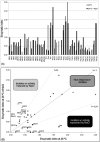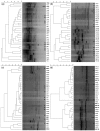Endo- and exoglucanase activities in bacteria from mangrove sediment
- PMID: 24516466
- PMCID: PMC3910219
- DOI: 10.1590/s1517-83822013000300048
Endo- and exoglucanase activities in bacteria from mangrove sediment
Abstract
The mangrove ecosystem is an unexplored source for biotechnological applications. In this unique environment, endemic bacteria have the ability to thrive in the harsh environmental conditions (salinity and anaerobiosis), and act in the degradation of organic matter, promoting nutrient cycles. Thus, this study aimed to assess the cellulolytic activities of bacterial groups present in the sediment from a mangrove located in Ilha do Cardoso (SP, Brazil). To optimize the isolation of cellulolytic bacteria, enrichments in two types of culture media (tryptone broth and minimum salt medium), both supplemented with 5% NaCl and 1% of cellulose, were performed. Tests conducted with the obtained colonies showed a higher occurrence of endoglycolytic activity (33 isolates) than exoglycolytic (19 isolates), and the degradation activity was shown to be modulated by the presence of NaCl. The isolated bacteria were clustered by BOX-PCR and further classified on the basis of partial 16S rRNA sequences as Alphaproteobacteria, Gammaproteobacteria, Actinobacteria, Firmicutes or Bacteroidetes. Therefore, this study highlights the importance of studies focusing on the endemic species found in mangroves to exploit them as novel biotechnological tools for the degradation of cellulose.
Keywords: cellulose; endo-1,4-β-D-glucanase; exo-1,4-β-D-glucanase; salinity.
Figures



References
-
- Angelo RS. Fungi: an introduction to biology, biochemist and biotechnology. Brazil: 2004. Hydrolytic enzymes; pp. 263–265.
-
- Bhat MK. Cellulase and related enzymes in biotechnology. Biotech Advan. 2000;18:355–383. - PubMed
-
- Bisaria VS, Ghose TK. Biodegration of cellulosic materials: substrates, microrganisms, enzymes and products. Enzy and Microbial Tech. 1981;3:90–104.
-
- Blumer-Schuette SE, Irina Kateava I, Westpheling J, Adams MWW, Kelly RM. Extremely thermophilic microrganisms for biomass conversion: status and prospects. Curr Opini in Biotech. 2008;19:210–217. - PubMed
Publication types
MeSH terms
Substances
Associated data
- Actions
- Actions
- Actions
- Actions
- Actions
- Actions
- Actions
- Actions
- Actions
- Actions
- Actions
- Actions
LinkOut - more resources
Full Text Sources
Other Literature Sources
